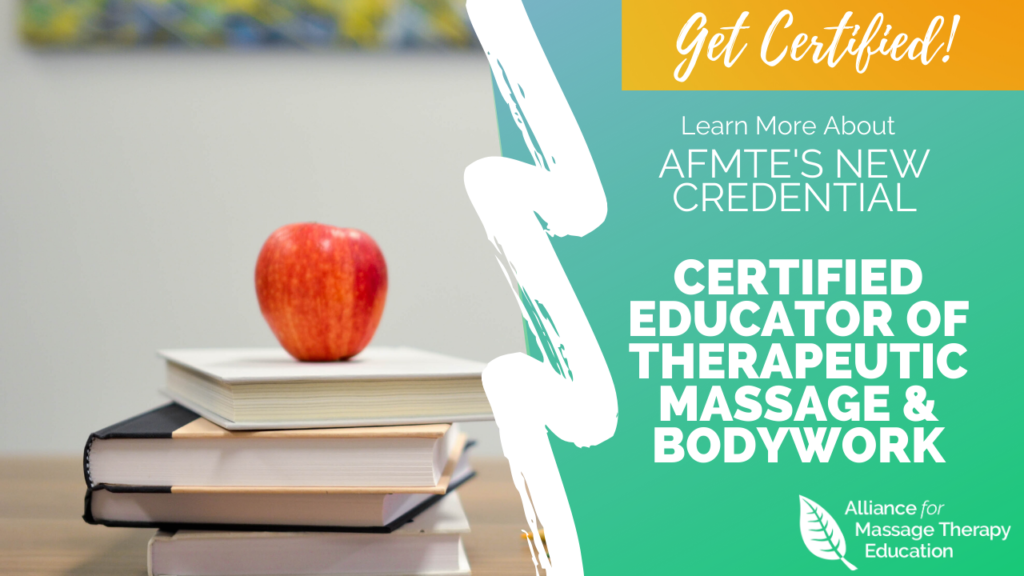
AFMTE CORE COMPETENCIES WITH DEANNA SYLVESTER
Preparing your portfolio to become a Certified Educator of Therapeutic Massage & Bodywork?
The AFMTE Core Competencies
Here’s a quick review of the AFMTE Core Competencies. The Core Competencies are a set of ten standards, each of which describes the knowledge, skills, and attitudes (KSAs) that form the basis for effective and successful teaching.
00:01 Hello, therapeutic massage and bodywork educators! Deanna Sylvester here. Right now you may be preparing your teaching portfolio to submit for peer review in order to become a certified educator.
As reviewers of your portfolio, we’re going to be looking for evidence that you meet the core competencies, so I thought it might be a good idea to do a quick review of what those core competencies are. Let’s do it!
00:31 Okay, you’ll notice that the ten core competencies or standards are organized into four categories that educators should know about and be able to demonstrate well and consistently, and that educators should hold valuable. So, having certain beliefs that influence your choices and decisions to act certain ways in particular circumstances.
00:53 And those four categories are the learner and learning, content, instructional practice, and professional responsibilities.
So within the learner and learning category, we have Standard 1, learner development and well-being. And competency here means you recognize that patterns of learning and development vary individually in physical, cognitive, emotional, spiritual, and social aspects, and you’re able to design and implement developmentally appropriate and challenging learning experiences. And you’re able to focus on the progress of your learners throughout that educational process.
01:43 Standard 2 is learning differences and integrative approaches. And competency here means that you use your understanding of individual differences and cultural factors to ensure an inclusive learning environment that enables your learners to meet their full potential, and you recognize the interconnected nature of human experience so you can provide your learners with rich opportunities for personal growth and integration.
02:13 And Standard 3, learning environments. Competency here means you’re able to work with learners to create an environment that supports individual and collaborative learning, and an environment that encourages positive social interaction and active engagement in learning and self-motivation. So that’s the learner and learning category.
02:37 In the content category, we have Standard 4, content knowledge. And competency here means you understand the central concepts, the tools of inquiry, and the structures of the subject that you teach. And you’re able to create learning experiences that make these aspects of your subject accessible and meaningful for your learners to assure their competency in that content.
03:08 Standard 5 is application of content. So, competency here means you understand how to connect theory and methodology, and how to use differing perspectives to engage your learners in critical thinking and creativity. Basically, you understand how to build the comprehensive skills needed for the practice of therapeutic massage and bodywork. So that’s the content category.
03:36 In instructional practice we have Standard 6, planning for instruction. So, competency here means you are able to plan instruction that supports every student in meeting well-defined learning objectives, by drawing upon your knowledge of the subject, the curriculum, the methods, and theories and practices of adult education. You’re also able to draw on your knowledge of your learners and your knowledge of the body-centered nature of therapeutic massage and bodywork.
04:08 Standard 7 is instructional strategies and delivery. And so competency here means you understand and use a variety of instructional strategies to motivate your learners to develop a comprehensive understanding of theory and methodology, to build their skills to apply that knowledge in meaningful and effective ways.
04:34 Standard 8 is observation and assessment. So, competency here means you understand and use multiple methods of assessment to engage and receive feedback from your learners, to observe and evaluate your learners’ progress, and to guide your learners’ decision-making and your own decision-making. So that’s the instructional practice category.
04:59 Then within the Professional Responsibility category we have Standard 9 professional development and ethical conduct. So, competency here means you participate in ongoing learning activities, you engage in your own self-reflection, and you receive input from others on the performance of your duties to increase your own knowledge and skills. And you bring a high level of ethical awareness to your work with learners and with colleagues, and you maintain a healthy balance in your professional life.
05:38 And finally it’s not enough to focus all of our attention on ourselves and our individual schools and classrooms, we need to keep that bigger picture in mind. So we have a 10th standard.
Standard 10 is collaboration. And competency here means you participate in activities that advance the art and science of therapeutic massage and bodywork through collaboration: collaboration with colleagues and other education and healthcare professionals.
06:10 OK. I hope this gives you a good overview reminder of the core competencies, and we look forward to seeing how you apply these standards in your teaching portfolio!

